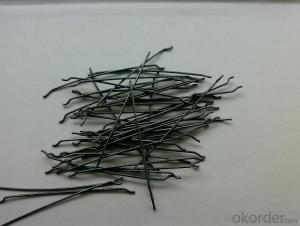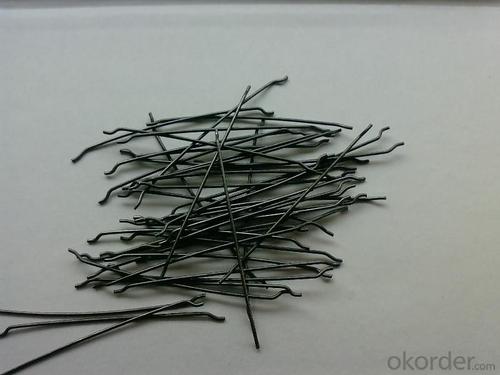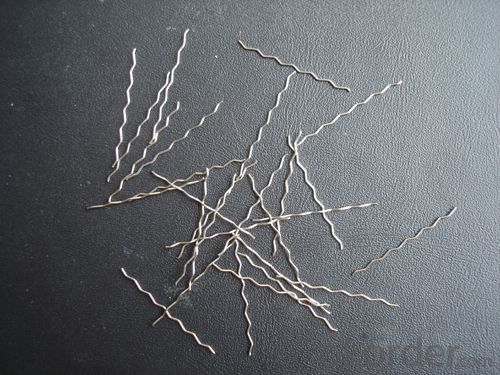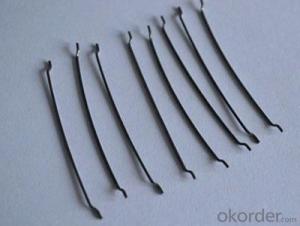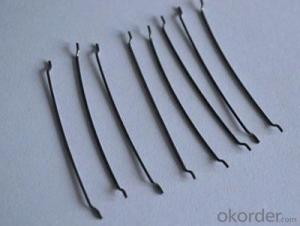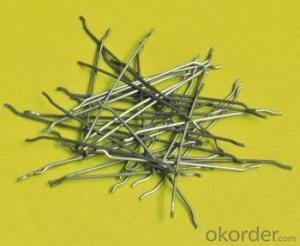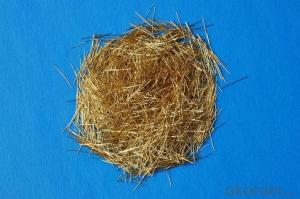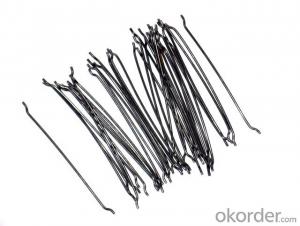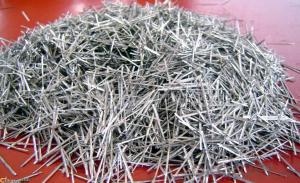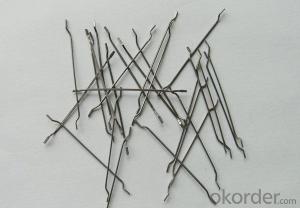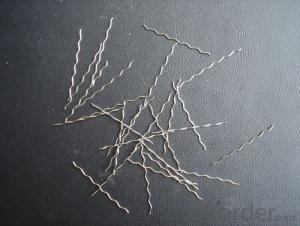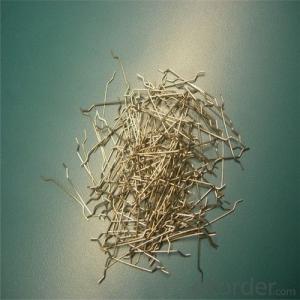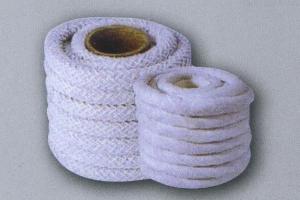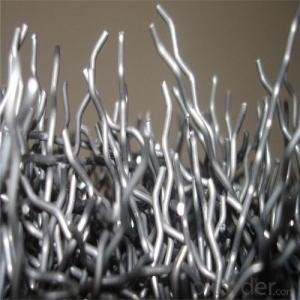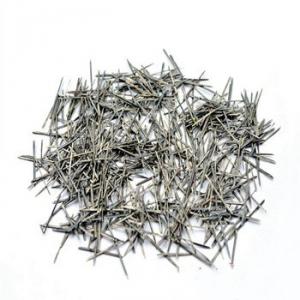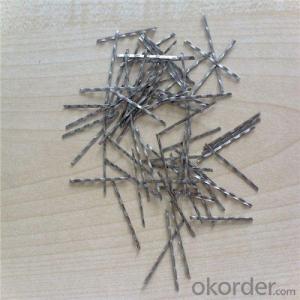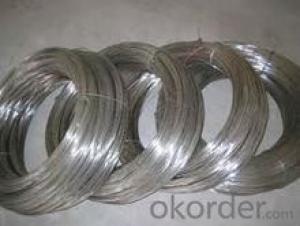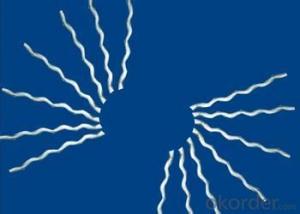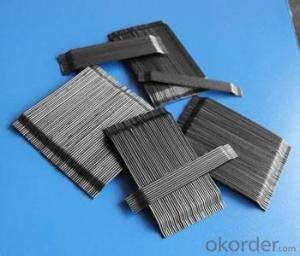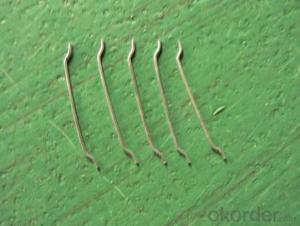Steel Fiber Cold drawn wire for Refractories Materials
- Loading Port:
- Tianjin
- Payment Terms:
- TT OR LC
- Min Order Qty:
- 5000 kg
- Supply Capability:
- 200000 kg/month
OKorder Service Pledge
OKorder Financial Service
You Might Also Like
Quick Details
Place of Origin: Shandong, China (Mainland)
Model Number: 38/40
Material: High quality low carbon steel
Tensile Strength: Min 700Mpa
Product features
Flat crimped steel fiber are manufactured by milling steel ingots. Compared with other steel fibers, its tensile strength is a little lower, about 600Mpa.
To achieve the same performance, the percentage of steel fibers should increases.
Specifications
Flat Crimped steel fiber | ||||
Type | Length(mm) | Tensile strength | ||
LB-30 | 30 | >=600Mpa | ||
LB-32 | 32 | >=600Mpa | ||
LB-35 | 35 | >=600Mpa | ||
Perform our country YB/T151-1999 "the concrete uses steel fibre " black metallurgy industry standard;
the JG/T3064-1999 steel fibre concrete building industry industry standard and ASTM A820 "Steel Fibres for Fibre-Reinforced Concrete"
Picture
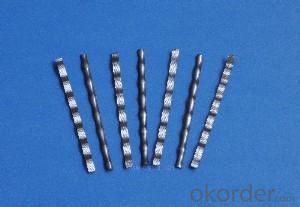
Easy-to-use
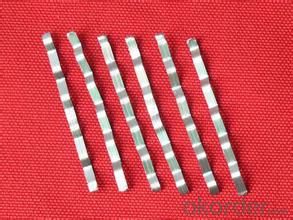
significantly increase impact, shatter and abrasion resistance;
Easy-to-use;
Extend durability and fatigue resistance;
Shotcrete, tunnel linings.
Mass concrete composite deck construction.
Precast concrete.
Industrial slabs on ground.
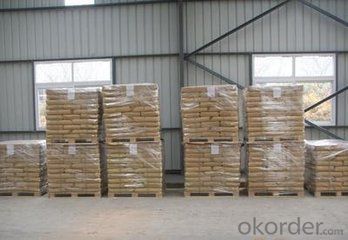
FAQ
we can produce any type steel fiber and of course we can make production according to your requirement
we have specilize in this field for almost 10 years ,with good quality and competitive price
To achieve the same performance, the percentage of steel fibers should increases.
- Q: Can melt extract stainless steel fiber be used in airport runway construction?
- Yes, melt extract stainless steel fiber can be used in airport runway construction. Stainless steel fiber is known for its high strength and durability, making it suitable for heavy-duty applications such as airport runways. It helps to enhance the overall performance and lifespan of the runway by providing reinforcement and reducing cracking. Stainless steel fibers also have excellent resistance to corrosion, which is crucial for withstanding the harsh environmental conditions experienced in airport settings. Additionally, the use of stainless steel fibers can help improve the skid resistance of the runway surface, ensuring safer landings and takeoffs for aircraft.
- Q: Can melt extract stainless steel fiber be used in precast bridge elements?
- Precast bridge elements can benefit from the utilization of melt extract stainless steel fibers. These fibers, renowned for their exceptional tensile strength, resistance to corrosion, and long-lasting nature, are well-suited for a variety of construction applications, including precast bridge elements. By incorporating these fibers into concrete, its mechanical properties like flexural strength and crack resistance can be significantly improved, thus enhancing the performance and lifespan of the bridge elements. Moreover, the implementation of stainless steel fibers can reduce the necessity for conventional reinforcement, resulting in cost-effective measures and expedited construction processes. Nevertheless, it is crucial to ensure that the proper dosage and distribution of fibers are meticulously controlled during the precast fabrication procedure to achieve optimal performance and structural integrity.
- Q: What are the different types of melt extract stainless steel fibers available in the market?
- There are several types of melt extract stainless steel fibers available in the market, including straight fibers, crimped fibers, hooked-end fibers, and corrugated fibers. These fibers vary in their physical characteristics and are used in various applications such as reinforcement in construction, thermal insulation, and electrical conductivity.
- Q: How does the addition of melt extract stainless steel fiber affect the ductility of concrete?
- The addition of melt extract stainless steel fiber generally improves the ductility of concrete. Stainless steel fibers act as reinforcements within the concrete matrix, enhancing its ability to withstand tensile stresses. This results in a higher ductility, allowing the concrete to undergo more deformation before failure.
- Q: Can melt extract stainless steel fiber be used in bridge abutments?
- Yes, melt extract stainless steel fiber can be used in bridge abutments. Stainless steel fibers have high tensile strength and excellent corrosion resistance, making them suitable for reinforcing concrete structures. In bridge abutments, which are critical components for supporting the bridge deck and transferring loads to the foundation, the use of stainless steel fibers can enhance the durability and overall performance of the structure. These fibers can effectively improve the crack resistance and flexural strength of the concrete, reducing the potential for cracking and improving the load-bearing capacity of the abutments. Additionally, the corrosion resistance of stainless steel fibers ensures long-term durability in harsh environmental conditions, such as exposure to moisture and deicing salts. Therefore, incorporating melt extract stainless steel fiber in bridge abutments can provide numerous benefits, including increased structural integrity, reduced maintenance needs, and extended service life.
- Q: How does melt extract stainless steel fiber affect the fire resistance of concrete?
- Melt extract stainless steel fiber significantly enhances the fire resistance of concrete. When added to concrete, these fibers create a three-dimensional network that improves the material's ability to withstand high temperatures and prevent cracking. As the concrete heats up during a fire, the stainless steel fibers act as a reinforcement, reducing spalling and maintaining the structural integrity of the concrete. Additionally, these fibers increase the thermal conductivity of the concrete, allowing heat to dissipate more efficiently and reducing the risk of thermal shock. Overall, the addition of melt extract stainless steel fiber greatly improves the fire resistance and durability of concrete structures.
- Q: Does melt extract stainless steel fiber improve the resistance to spalling of concrete?
- Concrete spalling is effectively reduced by the inclusion of melt extract stainless steel fiber. Spalling occurs when the outer layer of concrete chips or flakes away due to factors like freeze-thaw cycles, high temperatures, or chemical attacks. The incorporation of melt extract stainless steel fibers in the concrete mixture reinforces it, providing an extra layer of strength, and preventing spalling. The stainless steel fibers are well-dispersed throughout the concrete matrix, enhancing its overall tensile strength. When the concrete is subjected to stress, like during freeze-thaw cycles or high temperatures, the fibers help to evenly distribute the forces and prevent crack propagation. This reinforcement mechanism significantly decreases the likelihood of spalling, as the stainless steel fibers create a barrier that safeguards the surface layer from chipping off. Moreover, melt extract stainless steel fibers also enhance the durability and lifespan of the concrete. These fibers enhance its resistance to corrosion, which is a common cause of spalling in concrete exposed to harsh environments or chemical attacks. By providing a protective layer against corrosion, the stainless steel fibers ensure that the concrete maintains its structural integrity and remains resilient against spalling for an extended period. In summary, the inclusion of melt extract stainless steel fiber in concrete effectively improves its resistance to spalling. These fibers act as reinforcement, evenly distributing stress and preventing crack propagation, while also enhancing the concrete's durability and corrosion resistance.
- Q: What are the advantages of melt extract stainless steel fiber over other types of steel fibers?
- Melt extract stainless steel fibers provide numerous benefits compared to other varieties of steel fibers. To begin with, the corrosion resistance of melt extract stainless steel fibers is exceptional. The fibers contain a significant amount of chromium, which produces a protective oxide layer on their surface. This layer acts as a barrier against corrosive elements, ensuring high resistance to rust and deterioration. This advantage is particularly crucial in environments where exposure to moisture, chemicals, or elevated temperatures is common. Furthermore, the mechanical properties of melt extract stainless steel fibers surpass those of other steel fibers. These fibers are manufactured by melting the steel and subsequently rapidly extracting it into fine filaments. This process results in fibers with a high tensile strength, enabling them to withstand heavy loads and resist deformation under stress. This strength also enhances the durability and lifespan of structures reinforced with melt extract stainless steel fibers. Moreover, melt extract stainless steel fibers possess a high melting point, rendering them suitable for use in high-temperature applications. These fibers can endure extreme heat without compromising their structural integrity, making them ideal for reinforcing concrete in settings such as industrial furnaces, fire-resistant structures, and thermal power plants. Additionally, the fine and uniform nature of melt extract stainless steel fibers allows for better dispersion throughout the concrete matrix. This leads to enhanced crack resistance and improved load-bearing capacity of the reinforced concrete. The small diameter of these fibers also facilitates superior bonding with the surrounding concrete, resulting in increased bond strength and overall structural performance. Finally, melt extract stainless steel fibers exhibit excellent electrical conductivity. This makes them appropriate for applications requiring electrical grounding or conductivity, like electromagnetic shielding or structures exposed to electrical currents. In conclusion, melt extract stainless steel fibers offer a multitude of advantages, including superior corrosion resistance, high mechanical strength, resistance to high temperatures, improved crack resistance, enhanced bond strength, and excellent electrical conductivity. These factors establish them as the preferred choice over other steel fibers for a wide range of applications in the construction, infrastructure, and industrial sectors.
- Q: Does melt extract stainless steel fiber improve the fire resistance of concrete?
- Yes, melt extract stainless steel fiber does improve the fire resistance of concrete. When added to concrete, stainless steel fibers act as reinforcement, enhancing the strength and durability of the material. During a fire, these fibers help to slow down the spread of heat and prevent the concrete from cracking or spalling. Additionally, the high melting point of stainless steel ensures that it retains its structural integrity even under extreme temperatures. This improves the overall fire resistance of the concrete, making it a more reliable and safe construction material in fire-prone areas.
- Q: Can melt extract stainless steel fiber be used in concrete bridge decks?
- Yes, melt extract stainless steel fiber can be used in concrete bridge decks. Stainless steel fibers are commonly used as reinforcement in concrete structures, including bridge decks. These fibers improve the overall strength and durability of the concrete, enhancing its resistance to cracking and increasing its load-bearing capacity. Melt extract stainless steel fibers are known for their high tensile strength and corrosion resistance, making them an excellent choice for bridge decks exposed to harsh environmental conditions. Additionally, these fibers can help control shrinkage and prevent the formation of cracks, enhancing the long-term performance and service life of the bridge decks. Overall, melt extract stainless steel fiber is a suitable and beneficial reinforcement option for concrete bridge decks.
Send your message to us
Steel Fiber Cold drawn wire for Refractories Materials
- Loading Port:
- Tianjin
- Payment Terms:
- TT OR LC
- Min Order Qty:
- 5000 kg
- Supply Capability:
- 200000 kg/month
OKorder Service Pledge
OKorder Financial Service
Similar products
Hot products
Hot Searches
Related keywords
